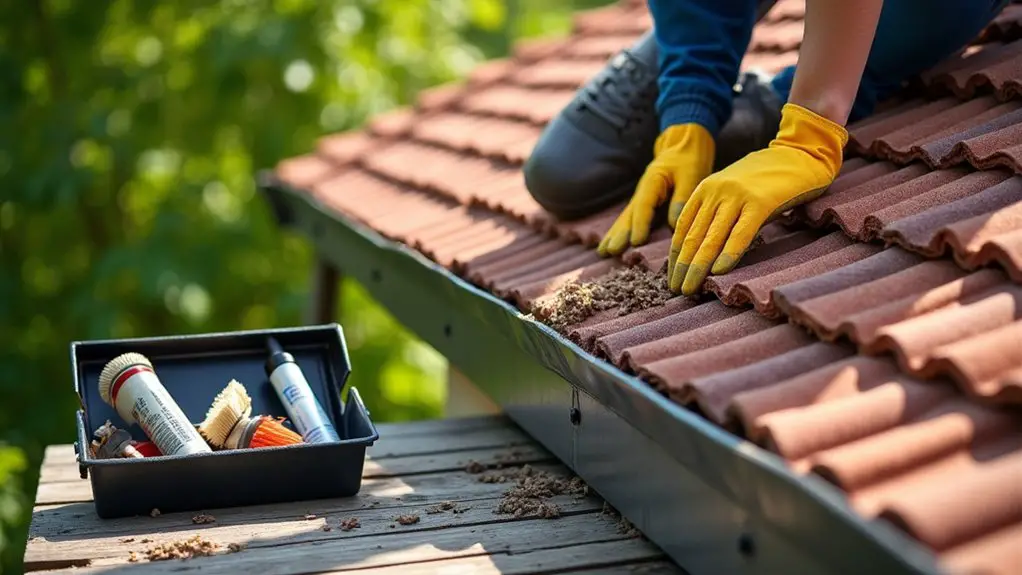Maximizing Roof Lifespan: Key Maintenance Tips

Maintaining your roof isn’t just about aesthetics; it plays an essential role in protecting your home. Regular inspections help catch issues before they escalate, saving you money and headaches down the line. But it doesn’t stop there. You’ll need to manage your gutters and ventilation, too. Curious about the key steps you can take to guarantee your roof stands the test of time? Let’s explore what it takes to keep your roof in prime condition.
Regular Inspections and Assessments
While you might not think about your roof often, regular inspections and assessments are essential for maximizing its lifespan. Checking for deformation, like warping or sagging, helps you identify potential load-bearing issues early on. Inspect for physical damage, such as cracks or punctures, to keep your roof secure. Don’t forget your attic—monitor for condensation or mold that could affect your home’s health. Fasteners on a metal roof should be verified for rust or looseness. Finally, guarantee proper drainage by checking slopes and flow; this keeps your roof safe and sound. By conducting regular inspections, you foster a stronger sense of belonging within your home, guaranteeing it remains a haven for you and your loved ones.
Gutter Maintenance and Water Management
How can you guarantee your roof remains protected from water damage? Start by ensuring your gutters are in top shape. Choose durable materials, like aluminum or galvanized steel, that can last decades with proper installation. Make sure they’re securely mounted and sloped adequately to avoid pooling water. Clogged gutters can lead to significant issues, so regularly check for debris and maintain flow. Use downspout extensions to direct water away from your foundation, preventing erosion. In colder climates, clear gutters before winter to avoid ice dams, and consider installing heating cables for extra protection. Regular maintenance can help you catch potential problems early, ensuring your roof—and everyone beneath it—remains safe and sound. Your home deserves the best care!
Vegetation and Debris Control
To keep your roof in top shape, managing vegetation and debris is essential. Start by trimming overhanging branches to reduce leaves and other organic mess. Consider installing root barriers to keep invasive plants at bay. Regular bi-annual inspections help you spot any troublesome growth before it becomes a bigger issue. When it’s time for cleanup, use blowers or vacuums to gently clear debris without damaging surfaces. After storms, aim to clean up within 72 hours to prevent clogged drains. If you’ve got a green roof, select drought-resistant plants for low maintenance, and maintain 80-100% coverage to outcompete invaders. These steps not only protect your roof but foster a sense of community care for shared spaces.
Ventilation and Insulation Optimization
Managing vegetation and debris is just part of maintaining a healthy roof; optimizing ventilation and insulation plays a key role too. By ensuring proper airflow and thermal management, you can greatly extend your roof’s lifespan. Here are some essential tips to take into account:
- Pair soffit and ridge vents for enhanced natural airflow.
- Install gable vents for homes without soffit access, ensuring secondary air intake.
- Clear debris from vents seasonally to avoid blockages and maintain circulation.
- Inspect and balance intake and exhaust vents to promote proper air pressure. Additionally, ensuring proper insulation acts as a barrier to extreme temperature transitions, which can prevent moisture from reaching the attic and reduce condensation proper insulation.
Preventive Repairs and Professional Care
While it’s easy to overlook roof maintenance amid everyday tasks, staying proactive with repairs and professional care is essential for extending your roof’s lifespan. Start by conducting seasonal inspections to catch worn-out areas or damaged shingles before they escalate into serious issues. Use binoculars or safely climb to check flashings, vents, and chimneys for cracks. Address minor damage immediately—replace missing shingles and apply sealant where needed. Schedule annual inspections with licensed contractors to guarantee thorough care, and consider adopting a maintenance contract to simplify the process. By integrating treatments like moss inhibitors and seasonal preparations, you reinforce your roof’s resilience against damage. Routine inspections aid in early detection of potential problems, contributing to a well-maintained roofing system. Together, these steps foster a community of homeowners dedicated to protecting their homes.





